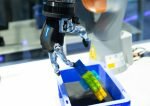
EMO Hannover 2019: Applying an “engineering approach” to the systematic use of artificial intelligence

EMO Hannover 2019: Applying an “engineering approach” to the systematic use of artificial intelligence

With the advent of smart factories, flexibility is becoming an increasingly important factor. According to SCHUNK’S vision, tomorrow’s grippers will enable flexible operations and even autonomous handling scenarios.
Conventional machine vision technology remains popular in the manufacturing factory, due to its proven repeatability, reliability, and stability. However, the emergence of deep learning technologies opens the possibility of expanded capabilities and flexibility, leading to more cost efficiency and higher production yield.

Okuma presents advanced automation and smart factory solutions at JIMTOF 2018

Smart factories are changing the world of manufacturing — and have become a revolutionary aspect of all kinds of industries. That’s the claim of many tech and industry experts who believe that optimising the manufacturing process to create an integrated and collaborative process will bring about the world’s next industrial revolution

When electricity was new, many companies didn’t know how to use the technology. In many ways, today’s companies have the same struggle with artificial intelligence (AI) in their processes, according to Silicon Valley-based Landing.AI.

The U.S. manufacturing sector is projected to lose the most jobs (-736,400) of any sector over the next decade. While this rate of loss is notably less than in the preceding period (2006 to 2016), factors affecting future projections are expected to be more heavily influenced by automation-enabling technologies. The popular misconception is that these automation-enabling technologies – e.g., robotics, machine learning, and Artificial Intelligence (AI) – will yield an overall net decrease in employment, rather than a re-appropriation of roles and responsibilities.

Advances in human-robot interaction, enabled by graphics displays, artificial intelligence and sensors, are ushering in a new generation of service robots that are easy to programme and intuitive to use. In Munich, from 19 to 22 June, 2018, automatica will demonstrate how state-of-the-art products and systems – from flexible, collaborative robot tools to smart warehouses and humanoids—place people at the heart of their design, enabling not only better assistance and collaboration but also reduced costs.

German Federal Chancellor Angela Merkel and Mexican President Peña Nieto set the tone on day one of the HANNOVER MESSE/CeMAT double-header. Asked to shake hands with a robot, they both went for the more casual fist bump – a symbol for the relaxed, natural interaction of humans with digitization, robots and machine learning.

On 27th March Festo presented a self-learning workplace for human-robot collaboration, the digital customer journey from “Learn”, “Build” and “Operate” to “Inspire”, the fusion of hardware and software in the context of digitalisation and further future-oriented Bionic and Future Concepts. This content from the Online Press Conference provides an overview of the Hannover Messe trade fair.